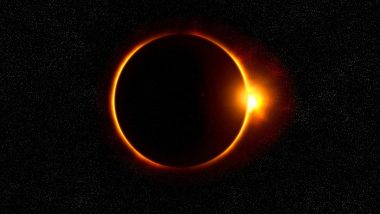Skywatchers and astronomy enthusiasts will be treated to a breathtaking celestial event - an annular solar eclipse on October 2. This phenomenon, often referred to as a "ring of fire" eclipse, occurs when the Moon passes directly in front of the Sun but is too far from Earth to completely cover the solar disk. As a result, a stunning ring of sunlight surrounds the dark silhouette of the Moon, creating a mesmerizing and unforgettable sight. Notably, this solar eclipse in India will coincide with Sarva Pitru Amavasya. In this article, we’ll learn about what an annular solar eclipse is, when and where it will occur, and its safety precautions.
What Is an Annular Solar Eclipse?
An annular solar eclipse, also known as Surya Grahan happens when the moon passes directly in front of the sun but is too far from Earth to completely cover the sun's disk. This results in a brilliant ring of sunlight encircling the moon, known as the "ring of fire." Unlike a total solar eclipse, where the sun is entirely obscured, an annular eclipse allows some of the sun's rays to remain visible, creating a unique and breathtaking sight.
When and Where Will Annular Solar Eclipse Take Place?
The annular solar eclipse will take place on October 2. The eclipse will begin around 10:56 UTC in the southern Pacific Ocean, and the point of the maximum eclipse will occur at 12:25 UTC over Argentina. The eclipse will last approximately three hours and end around 13:52 UTC in the southern Atlantic Ocean. In India, the eclipse will occur at 9:12 PM and will coincide with Sarva Pitru Amavasya, a day dedicated to paying homage to one's ancestors and seeking their blessings and forgiveness.
Safety Precautions for Surya Grahan
While observing an annular solar eclipse can be an awe-inspiring experience, it is crucial to take proper safety precautions. Viewing the sun without appropriate eye protection can cause severe and permanent eye damage. To watch the eclipse safely, it is important to use specially designed solar viewing glasses or handheld solar viewers. Ordinary sunglasses, even very dark ones, are unsafe for looking at the sun.
The annular solar eclipse on October 2, 2024, promises to be remarkable for sky enthusiasts and casual observers alike. By taking the necessary precautions and planning ahead, you can safely enjoy this natural wonder. Whether you witness the eclipse from a bustling city or a tranquil countryside, the "ring of fire" will undoubtedly be a memorable sight, reminding us of the beauty and intricacy of our universe.
(The above story first appeared on LatestLY on Jul 29, 2024 10:02 AM IST. For more news and updates on politics, world, sports, entertainment and lifestyle, log on to our website latestly.com).













 Quickly
Quickly




















